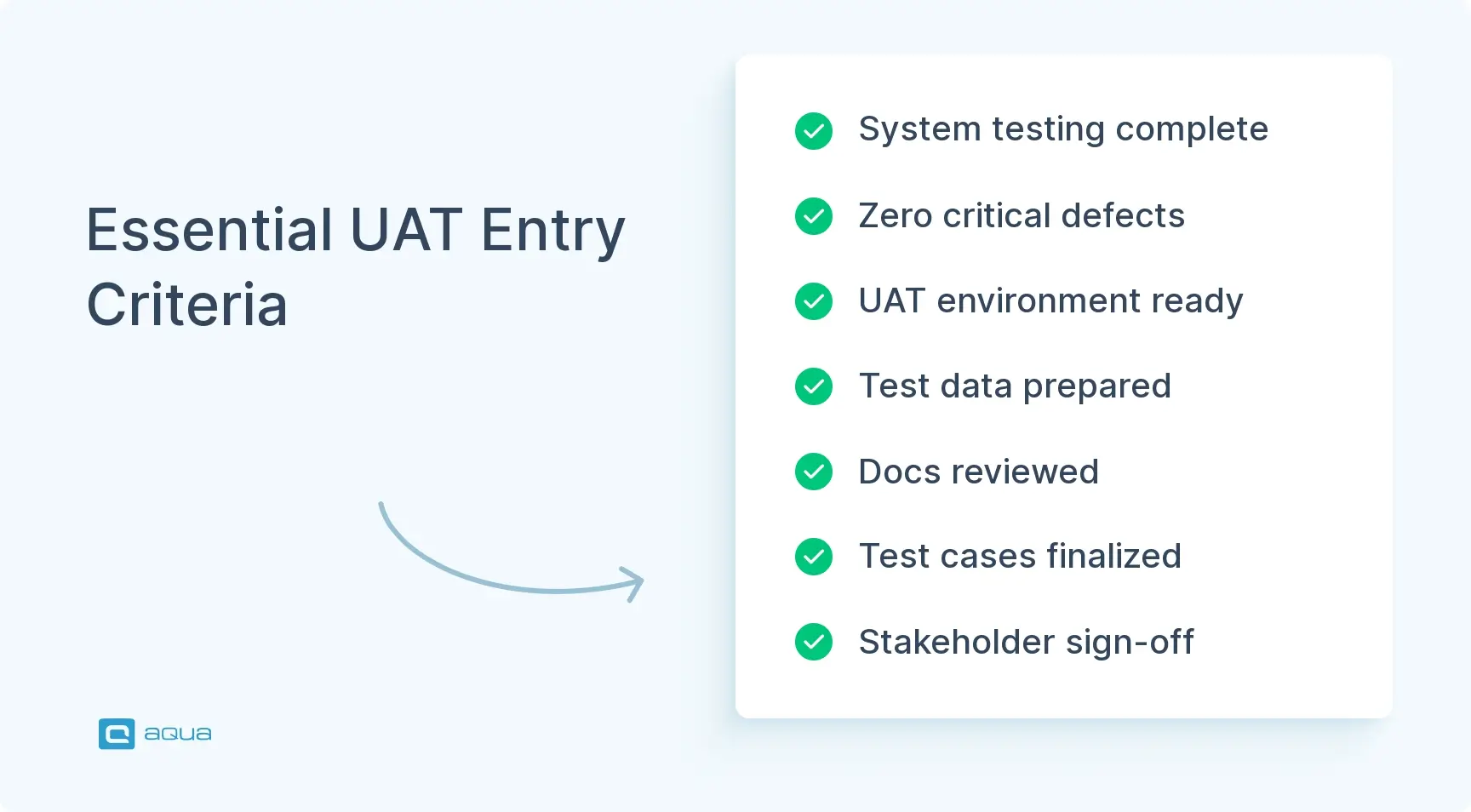What is an Entry Criteria in User Acceptance Testing?
Entry criteria define the minimum conditions your software must meet before UAT begins. They act as quality gates that prevent teams from testing unstable or incomplete software.
Essential UAT Entry Criteria
- Previous Testing Completion: System testing, integration testing, and functional testing should be finished with acceptable pass rates. Define specific thresholds like “95% of test cases must pass.”
- Bug Severity Limits: All critical and high-severity defects must be resolved. Set clear numbers such as “zero Priority 1 bugs and fewer than five Priority 2 bugs remaining.”
- Test Environment Readiness: UAT environment should mirror production conditions, including similar hardware, network configurations, and integration points.
- Test Data Preparation: Realistic test data representing actual user scenarios must be available, covering normal operations and edge cases.
- Documentation Availability: User manuals, help files, and supporting documentation should be complete and reviewed.
- UAT Plan and Test Cases Ready: Documented test cases covering all user requirements must be prepared and reviewed by stakeholders.
- User Preparation Complete: Testers must understand their roles and receive necessary training on the system and testing processes.
- Stakeholder Sign-offs Obtained: Formal approval from project stakeholders confirms the product meets entry criteria and is ready for user validation.

These criteria prevent wasted time testing software that isn’t ready and ensure UAT focuses on meaningful user validation rather than basic functionality issues.
What is an Exit Criteria in User Acceptance Testing?
Exit criteria define when UAT is complete and the software can move to production. They create objective standards for determining when testing is sufficient and prevent both endless testing cycles and premature releases.
Essential UAT Exit Criteria
- Test Execution Coverage: A predetermined percentage of test cases must be executed, typically 95-100%. This ensures comprehensive validation of system functionality.
- Defect Resolution Rate: All critical and high-priority defects must be fixed and verified. Define specific targets like “100% of Priority 1 defects resolved, 95% of Priority 2 defects resolved.”
- Open Defect Thresholds: Set limits on remaining defects by severity. For example: “No critical defects, maximum of 3 high-severity defects with documented workarounds.”
- User Sign-off: Formal acceptance from user representatives confirming the system meets their business needs and requirements.
- Performance Requirements: Confirmation that the system meets specified performance standards under expected user loads and usage patterns.
- Documentation Completion: All user documentation must be complete, accurate, and approved by stakeholders.
- Training Completion: All necessary end-user training has been conducted, and users are prepared for system deployment.
- Regression Testing Results: Verification that defect fixes haven’t broken previously working functionality through systematic regression testing.
- Compliance Verification: Confirmation that the system meets all regulatory, security, and organisational compliance requirements.
These criteria prevent projects from releasing prematurely or getting stuck in endless testing loops by providing clear, measurable standards for UAT completion.
As you’re developing your UAT strategy with clear entry and exit criteria, consider how the right test management solution can transform this critical process. aqua cloud provides a structured framework to define, track, and manage your UAT criteria effectively. With aqua’s comprehensive requirements management, you can easily establish traceability between business needs and test cases, ensuring nothing falls through the cracks. The platform’s customisable reporting dashboards give real-time visibility into your UAT progress against defined criteria, while AI-powered test case generation helps you achieve thorough coverage in a fraction of the time. To enhance your toolkit and turn aqua’s test management capabilities into superpower, aqua integrates with Jira, Confluence, Azure DevOps, Selenium, Jenkins, Ranorex and many more. Instead of struggling with spreadsheets and disconnected tools to track UAT completion, aqua centralises everything in one intuitive platform, making it simple to determine when your software is truly ready for release.
Transform your UAT process with structured entry/exit criteria tracking
The Importance of Entry and Exit Criteria for User Acceptance Testing
Clear UAT criteria aren’t bureaucratic overhead. They solve real problems that derail testing efforts and create expensive post-release surprises.
Benefits of Entry Criteria
- Prevents Wasted Testing Effort: Entry criteria ensure the system is actually ready before users invest their time. This prevents frustrated testers from encountering obvious bugs that should have been caught earlier.
- Sets Clear Expectations: Everyone understands what must be accomplished before UAT begins, eliminating confusion about project readiness and reducing finger-pointing when delays occur.
- Improves Resource Utilization: Testing resources get used efficiently when systems are in genuinely testable states rather than being wasted on premature validation attempts.
- Creates Quality Accountability: Establishes clear quality gates that hold teams accountable for completing work properly before moving to the next phase.
Benefits of Exit Criteria
- Enables Objective Release Decisions: Removes emotional or schedule-driven pressure to release before the software is ready by providing measurable standards for completion.
- Manages Stakeholder Expectations: Creates transparency around what “done” actually means, preventing disputes about whether the system is ready for production.
- Reduces Production Issues: Ensures critical problems are addressed before deployment, preventing expensive emergency fixes and user frustration.
- Provides Documentation Trail: Creates evidence of due diligence for compliance, governance, and post-release issue analysis.
- Builds Team Confidence: Teams and stakeholders gain confidence that released products meet established quality standards rather than hoping for the best. The benefits compound over time as teams develop discipline around quality gates and avoid the costly cycle of releasing inadequately tested software.
Make sure you have a test approach document that outlines entry/exit criteria, the test scope, how issues are managed and what will be presented for acceptance by the customer (you) - that is, assuming your role has that kind of authority.
Common Challenges in Establishing Entry and Exit Criteria
Teams frequently stumble when implementing UAT criteria, even with good intentions. Recognizing these challenges helps you avoid the most common pitfalls.
Stakeholder Alignment Issues
Without clear, documented criteria for ‘ready for testing’ or ‘ready for production,’ conflicts inevitably arise between business priorities and technical reality. Business stakeholders focus on features and deadlines while technical teams emphasize stability and performance.
A financial application team faced this when business users wanted to start UAT despite known database integration issues because of quarterly reporting deadlines.
Solution: Their approach involved phased UAT, testing stable modules first while resolving critical integration problems in parallel.
Balancing Thoroughness with Timelines
Pressure to move faster leads to criteria that are either too lenient or impossibly strict, both of which create problems.
A healthcare software team initially required 100% test execution with zero open defects. After multiple delayed releases, they focused exit criteria on critical patient safety scenarios with zero defects while allowing minor UI issues to be addressed post-release.
Solution: Focus exit criteria on critical scenarios with zero tolerance while allowing non-critical issues to be addressed in future releases.
Vague Criteria Definitions
Unclear criteria lead to subjective interpretations and disagreements about readiness. Instead of “system should be stable enough for testing,” specify measurable conditions like “system must remain operational for 8 consecutive hours under simulated user load with no critical crashes.”
Solution: Replace subjective language with specific, measurable requirements that eliminate interpretation differences.
Resistance to Formal Processes
Teams new to structured testing may view formal criteria as bureaucratic overhead that contradicts agile principles.
Solution: Frame criteria as quality enablers rather than bureaucratic checkpoints. Show how clear standards actually support agile by preventing waste, rework, and failed iterations.
Documentation and Tracking Difficulties
Monitoring criteria status across multiple releases and projects becomes unwieldy without proper systems and tools.
Solution: Many teams find success using test management tools that integrate with issue tracking systems to automatically monitor and report criteria status across projects.
The key is recognising these challenges early and building solutions into your process rather than hoping they won’t appear in your project.
Best Practices for UAT Criteria Management
Understanding challenges is just the first step. There are ways to create and implement criteria that actually work for your team and project. Let’s look at the best practices.
Creating Effective Entry Criteria
- Keep It Relevant: Include only criteria that genuinely impact effective testing. Avoid adding requirements that sound important but don’t affect UAT quality.
- Make It Measurable: “All critical defects resolved” beats “system is stable enough.” Specific numbers eliminate interpretation disputes.
- Right-Size for Your Project: A two-week mobile app update needs different criteria than a major enterprise system upgrade. Match criteria complexity to project scope.
- Get Early Buy-In: Involve stakeholders in criteria definition at project start, not when approaching UAT. Early agreement prevents last-minute conflicts.
Developing Robust Exit Criteria
- Focus on User Acceptance, Not Perfection: Zero defects is rarely realistic. Focus on what actually impacts user success and business operations.
- Include Non-Functional Requirements: Performance, security, and usability should have specific acceptance thresholds, not just functional requirements.
- Plan for Exceptions Define approval processes for rare situations when exceptions to exit criteria might be necessary.
- Document Business Impact For criteria that might not be met, document potential business impact to aid decision-making.
Sample UAT Criteria Templates
Entry Criteria for UAT Checklist:
| Criteria Category | Requirements | Status |
|---|---|---|
| Previous Testing | System testing complete with >90% pass rate | ✔ |
| Defect Status | Zero open P1 defects; <5 open P2 defects | ✔ |
| Environment | UAT environment configured and stable | ✔ |
| Test Assets | UAT test cases reviewed and approved | ✔ |
| Documentation | User guides and training materials available | ✔ |
| Team Readiness | UAT testers identified and trained | ✔ |
UAT Exit Criteria Template:
| Criteria Category | Requirements | Status |
|---|---|---|
| Test Execution | 100% of critical path test cases executed | ✔ |
| Defect Resolution | All P1/P2 defects resolved; <10 P3 defects | ✔ |
| Performance | Response times meet SLAs under expected load | ✔ |
| User Feedback | >90% of users confirm requirements are met | ✔ |
| Documentation | All known issues documented with workarounds | ✔ |
| Compliance | Security scan completed with no critical findings | ✔ |
Industry-Specific Examples
- Financial Sector: All security vulnerability tests pass with no high or critical findings, 100% of regulatory compliance test cases executed with 100% pass rate.
- E-commerce Platform: System sustains peak load of 10,000 concurrent users with response times under 2 seconds, all payment processing test cases pass with 100% accuracy.
- Healthcare Application: All patient data handling functions verified with zero defects, HIPAA compliance confirmed through specialized test scenarios.
Continuous Improvement
The most effective teams treat UAT criteria as living documents that evolve based on experience and results.
Conduct post-UAT retrospectives to identify criteria that were too strict, too lenient, or missing entirely. Analyse production issues to identify gaps in exit criteria. Refine criteria based on customer feedback and changing business priorities.
According to a Quality Assurance whitepaper by Capgemini, organisations that regularly review and update their testing criteria show a 37% improvement in defect detection rates over time.
Regular refinement ensures your criteria remain relevant and effective as your projects and organisation mature.
As you implement robust entry and exit criteria for your UAT process, having the right acceptance testing tools can make all the difference between chaotic testing and structured validation. aqua cloud offers a complete ecosystem for managing every aspect of your UAT workflow, from defining clear criteria to tracking progress and ensuring comprehensive test coverage. With aqua’s AI-powered test case generation, you can develop thorough test scenarios that address all your requirements in seconds rather than hours. The platform’s built-in traceability ensures that every requirement is covered, while customizable dashboards give stakeholders immediate visibility into UAT progress against defined exit criteria. Integration with tools like Jira, Confluence, Azure DevOps keeps everything synchronised, and the intuitive defect management system helps you track issues until resolution. Why struggle with makeshift solutions when you can leverage a purpose-built platform that transforms your UAT from a subjective process into a structured, measurable activity that delivers software users truly love?
Achieve 100% structured and traceable UAT processes with comprehensive criteria management
Conclusion
UAT entry and exit criteria transform chaotic testing processes into structured validation that protects both your team and your users. These standards prevent wasted effort on unfinished software while ensuring completed products actually meet user requirements. The most effective criteria evolve with your team’s experience and product complexity, focusing on what genuinely impacts user success rather than bureaucratic compliance. Implement criteria that matter to your specific context and business needs. The goal isn’t perfect documentation but delivering real software that users can trust and adopt successfully.


















